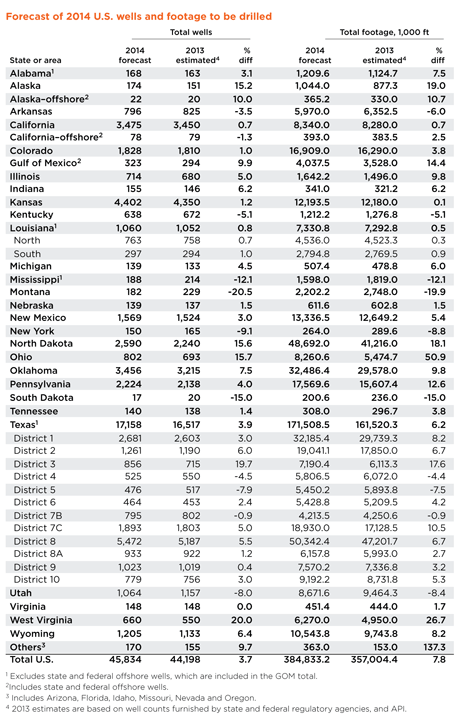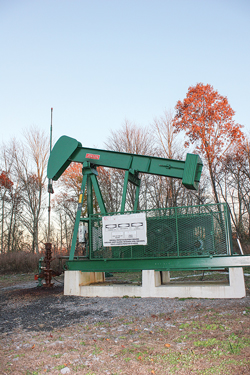U.S. drilling rides high, but challenges remain
The global E&P industry is riding the crest of a wave, and nowhere is that more true than in the U.S. For the last three years—and for this fourth year as well—drilling activity has remained in a narrow band of not more than 4,000 wells’ difference.
|
The global E&P industry is riding the crest of a wave, and nowhere is that more true than in the U.S. For the last three years—and for this fourth year as well—drilling activity has remained in a narrow band of not more than 4,000 wells’ difference. In recent years, the upstream industry has not seen another steady period like this one. Underpinning these well counts has been the inter-play between pad drilling, greater efficiencies achieved in drilling complicated wells, and the rig count, itself. However, the industry is also beginning to run up against some inherent service-and-supply constraints in a few states.
As regards oil prices, WTI Spot averaged $97.91/bbl at Cushing, Okla., last year, while Brent averaged $108.64. This year, World Oil forecasts the average WTI price at $91.50/bbl, and Brent at $104.29. The U.S. natural gas price at Henry Hub rose 35% over the 2013 average to $4.24/Mcf in December 2013. Based on this trend, and other indicators, World Oil predicts the Henry Hub price will average $3.95/Mcf in 2014. Given these positive indicators, and the analysis of our proprietary surveys of operators and U.S. state agencies, World Oil forecasts the following:
U.S. FUNDAMENTALSTwice a year, Barclays Capital analysts conduct an extensive upstream spending survey, where they have analyzed actual spending for 2013 and planned expenditures for 2014. In their survey sample, U.S. E&P expenditures will rise 8.5% this year, to just over $156 billion, as opposed to nearly $144 billion last year (for more details on spending, see page 33). High oil prices for the last three years have provided U.S. operators a sustained incentive to drive up production from liquids-rich shale plays, as well as conventional production from the Gulf of Mexico. Crude oil production has climbed steadily since 2012, to above 8.0 MMbopd in December 2013. Meanwhile, relatively low gas prices have resulted in a slow increase in U.S. gas production, to slightly above 70 Bcfd by October 2013. If the Henry Hub gas price stays above $4/Mcf, there should be some incentive for dry gas operators to increase their production. The U.S. rig count dropped from a high of 2,000 in January 2012, but it has stabilized between 1,700 and 1,800 units throughout 2013. Year-on-year, there was an 8.2% drop between 2012 and 2013. While this trend indicates sustained activity, we believe that footage drilled provides a better barometer of drilling activity. Indeed, U.S. footage has climbed since 2010 and is approaching 400,000 ft. This is because of the increasing trend in North American shale plays to construct long laterals from a single mother well through multi-well pad drilling. This has resulted in significant rig efficiencies. As such, the demand for rigs has shifted to fewer, higher-efficiency rigs, but the demand for expendables, such as drill bits and drilling fluids and OCTG goods, is still going up.
In 2013, our original forecast called for just over 47,000 wells. However, when the rig count failed to budge by the middle of the year, we reduced our summer revision of the forecast by 3,000 wells, to under 44,000. Now that we have the benefit of more complete numbers, the actual U.S. well count for last year has come in between those two forecasts, at 44,198 wells. The reason for this is related to the rig count. After looking at various data and interviewing industry personnel in several regions, it became apparent that up to half of the 158-rig difference between 2012 and 2013 failed to impact the well count at all, because pad drilling, and other efficiency gains, made up that portion of the difference. Last, but not least, throughout 2014, the drilling split between oil and gas has been about 80% in favor of oil. If the Henry Hub gas price stays above $4 per Mcf, we expect dry gas drilling to show a cor-responding increase. THE YEAR AHEAD–2014Given the aforementioned trends, World Oil expects a moderate increase in our national forecast. To arrive at our estimate of wells drilled in the U.S. during the past year, and our forecast for this year, World Oil surveyed state and federal agencies, and operators, and combined those results with rig counts and other data. We forecast that drilling will be up nearly 4% in 2014, to 45,834 wells. Footage drilled should rise at a faster, 7.8% rate, to 384.8 million ft of hole. This is due to the greater, average footage being drilled per well. Operator surveys. World Oil surveyed 15 major U.S. drillers (integrated companies and independents with large drilling programs) and 85 independent operators (a cross-section of small- and medium-sized firms) working in key areas. Their data yielded some interesting trends. Among the major drillers, 6,842 wells were drilled nationwide, of which just 240, or 3.5%, were exploratory. This year, these companies will boost their drilling 2.0%, to 6,981 wells, but only 205 wells, or a paltry 2.9%, will be for exploration. Last year, 46.1% of the wells (3,151) drilled by this group were horizontal, and that figure will rise to 49.2% in 2014. An overwhelming share of their drilling last year, 5,243 wells, or 76.6%, was oil-directed. This year, they will direct 5,548 of their wells, or 79.5%, toward oil. Average footage drilled per well by this group in 2013 was 8,490 ft. This year, that figure should climb to 9,625 ft, reflecting greater use of horizontal wells with long laterals. In the independent group, 1,243 wells were drilled nationwide, of which 163, or 13.1%, were exploratory. This year, these companies will increase drilling 7.1%, to 1,331 wells. Of that figure, 190 wells, or 14.3%, will be for exploration. During 2013, 29.1% of the wells (362) drilled by this group were horizontal, but that figure will bump up to 32.5% (432 wells) this year. Just like the major drillers, a massive amount of the drilling last year, 92.3%, or 1,147 wells, was oil-directed. That figure will be 90.9%, or 1,210 wells, in 2014. Average footage drilled per well by independents in 2013 was 8,745 ft. That figure will actually be a bit lower this year, at roughly 8,415 ft. State-by-state statistics. In the U.S. Gulf of Mexico, activity continues to recover in the post-Macondo era. World Oil estimates that wells drilled last year were up 15.3%, and expects a 9.9% increase this year. Last year, the Bureau of Safety and Environmental Enforcement approved permits for 280 new wells in shallow waters and 394 in deep water. There is no longer a permitting bottleneck, and, crucially, the operators and the federal agency appear to be in sync regarding permitting. New production platforms in the Gulf of Mexico are expected to grow from 35 to 60 by 2015.
Further exploration activity will be spurred by BP’s significant oil discovery at its Gila prospect in Keathley Canyon Block 93. Also in deep water, discoveries are continuing along the Miocene trend. In December, Noble Energy announced its Dantzler find, which complements existing developments at Rio Grande and Gunflint. And in May, ExxonMobil announced a $4-billion plan to develop its deepwater Julia field in the Walker Ridge area. During 2013, Texas drilling hit a plateau, as the U.S. industry took a collective pause, and the number of wells actually declined 3.8%. This year, World Oil expects Texas to gain back that 3.8% and, essentially, return to the 2012 level, with 17,158 wells. Activity continues to be driven by the Permian basin and Eagle Ford shale. Two of the more significant increases in activity will be in those areas. Nine of 12 Railroad Districts will have increases this year. In the Permian (all or part of Districts 8, 8A and 7C), drilling totaled more than 7,900 wells last year. This year, World Oil predicts that the Permian region will gain about 5%, to nearly 8,300 wells. Activity continues to be driven by high oil prices, horizontal drilling and multi-stage completions. And operators continue to target several unconventional formations. In the Eagle Ford shale of South Texas (mainly Districts 1, 2 and 4), new activity records are being set annually, particularly in District 1, and last year was up several percentage points. As operators take advantage of the play’s liquids side, average footage per well is rising. Operators are pushing farther eastward, as they explore and prove up additional acreage.
In Louisiana, the state’s northern portion has been weaning itself off the once-venerable Haynesville shale in recent years, while gas prices have remained low (Editor’s note: The Haynesville covers Texas District 6, in addition to portions of northern Louisiana). Operators continue to shun drilling for gas in favor of oil, particularly in the Haynesville. The state’s Office of Conservation reports that last year’s 80-20 ratio in favor of oil continues. In addition, regulators say that the overall activity level in northern Louisiana will remain at almost exactly last year’s level. In southern Louisiana, where oil activity is traditionally higher, the volume of drilling is only a third of the northern half, but the level is steady. Regulators also expect a carbon copy of last year’s drilling performance in this half of the state, so World Oil predicts a 1% increase to just short of 300 wells. Oklahoma drilled 3,215 wells last year, and we expect that number to increase 7.5% this year. There is some unconventional drilling in the Woodford shale, along with the state’s conventional oil and gas. This balanced mix of activity has helped Oklahoma maintain a multi-year, unbroken string of drilling increases. A particular center of growth continues to be the Granite Wash play. North Dakota was producing 950,000 bopd in late 2013, thanks to the Bakken shale, and will break the 1-million-bopd figure shortly, this year. That will make North Dakota the only state, besides Texas, to produce in excess of 1-million bopd. Drilling last year was about level with 2012, at 2,240 wells. This year, state officials expect 2,590 wells, a 15.6% gain. Due to horizontal drilling and long laterals, footage per well exceeded 19,500 last year, and World Oil’s survey group indicates that it will be closer to 20,000 ft this year. Despite the problems with low natural gas prices, there has been some optimism in the Marcellus shale portion of the Northeastern U.S. Operators have been able to take advantage of the play’s wet gas and liquids portions in western Pennsylvania and northwestern West Virginia, resulting in fairly high activity levels. At the same time, they have reduced activity in the dry gas areas of eastern Pennsylvania, northeastern West Virginia and New York. In addition, companies are drilling numerous wells in the liquids-rich Utica shale of eastern Ohio and western Pennsylvania. Thus, overall, World Oil sees activity increasing 8.2% to 3,836 wells. In Alaska, Republican Gov. Sean Parnell has repealed the Palin oil tax—named after former Governor and Vice Presidential candidate Sarah Palin, who instituted the tax in 2007. This should end Alaska’s 20-year-old production slump. Last year, the state dropped to fourth place, after California, among oil-producing states. BP and ConocoPhillips have added two rigs, apiece, and ConocoPhillips is considering an export option to Asia. In the Chukchi Sea offshore Alaska, where Shell’s Kulluk drilling rig grounded in 2012, the firm had obtained a replacement rig from Transocean, and had intended to return to the area. But now, there are regulatory concerns, which have forced Shell to postpone Arctic drilling for yet another year. In January, the 9th Circuit Court of Appeals issued a ruling that the Department of the Interior violated existing law, when it opened almost 30 million acres of Alaska’s outer continental shelf to drilling. The ruling found that the federal environmental assessment was flawed, throwing existing leases into question. The matter has been tossed back to a federal judge for further action. In California, activity was up 8.7% last year, led by Occidental Petroleum and Aera Energy, the state’s largest oil and gas producers. These companies, along with other producers, remain focused on rel-atively safe oil plays, with development work ranging from conventional wells to steam floods, water floods and shales. The California state agency for oil and gas predicts that drilling will flatten out this year, at just under 3,500 wells.
In 2014, the Rocky Mountain states, as a group—where activity is concentrated in Colorado, Wyoming, New Mexico, Utah and Montana—will be about identical with last year’s activity, with 5,848 wells expected to be drilled. Three states—Colorado, Wyoming and New Mexico—will be up moderately. In the largest driller, Colorado, activity has shifted overwhelmingly toward oil, with a majority of the activity now concentrated in the Niobrara shale. In Wyoming, 62% of all wells will be directed toward oil. In New Mexico, the lion’s share of activity remains shifted to the southeastern half of the state. |
||||||||||||||||||||||||||||||||||||||||||||||||
- The last barrel (February 2024)
- E&P outside the U.S. maintains a disciplined pace (February 2024)
- International drilling and production: Growth outside the U.S. continues at measured pace (February 2023)
- U.S. reserves: U.S. proved reserves experience significant increase (February 2023)
- U.S drilling: U.S drilling activity to climb as supply disruption continues (February 2023)
- Canadian E&P: Canada’s upstream on track to strengthen during 2023 (February 2023)
- Applying ultra-deep LWD resistivity technology successfully in a SAGD operation (May 2019)
- Adoption of wireless intelligent completions advances (May 2019)
- Majors double down as takeaway crunch eases (April 2019)
- What’s new in well logging and formation evaluation (April 2019)
- Qualification of a 20,000-psi subsea BOP: A collaborative approach (February 2019)
- ConocoPhillips’ Greg Leveille sees rapid trajectory of technical advancement continuing (February 2019)







